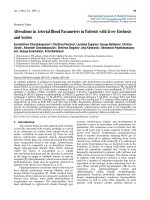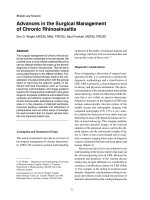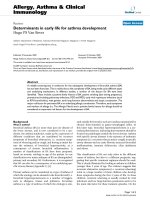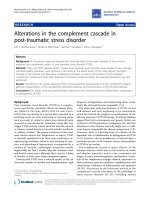Báo cáo y học: "Methemoglobinemia in critically ill patients during extended hemodialysis and simultaneous disinfection of the hospital water supply" pdf
Bạn đang xem bản rút gọn của tài liệu. Xem và tải ngay bản đầy đủ của tài liệu tại đây (99.98 KB, 4 trang )
Open Access
Available online />Page 1 of 4
(page number not for citation purposes)
Vol 13 No 5
Research
Methemoglobinemia in critically ill patients during extended
hemodialysis and simultaneous disinfection of the hospital water
supply
Martin Johannes Bek
1
, Sven Laule
2
, Christine Reichert-Jünger
1
, Rainer Holtkamp
2
,
Michael Wiesner
3
and Cornelius Keyl
2
1
Dialysis Centre Bad Krozingen, Heart Centre Bad Krozingen, Suedring 15, 79189 Bad Krozingen, Germany
2
Department of Anesthesiology, Heart Centre Bad Krozingen, Suedring 15, 79189 Bad Krozingen, Germany
3
Department of Heart Surgery, Heart Centre Bad Krozingen, Suedring 15, 79189 Bad Krozingen, Germany
Corresponding author: Cornelius Keyl,
Received: 10 Jul 2009 Revisions requested: 3 Aug 2009 Revisions received: 26 Aug 2009 Accepted: 12 Oct 2009 Published: 12 Oct 2009
Critical Care 2009, 13:R162 (doi:10.1186/cc8128)
This article is online at: />© 2009 Bek et al.; licensee BioMed Central Ltd.
This is an open access article distributed under the terms of the Creative Commons Attribution License ( />),
which permits unrestricted use, distribution, and reproduction in any medium, provided the original work is properly cited.
Abstract
Introduction To evaluate the cause of methemoglobinemia in
patients undergoing extended daily hemodialysis/
hemodiafiltration we analyzed the relationship between
methemoglobinemia and the water disinfection schedule of the
hospital.
Methods We reviewed all arterial blood gas analyses, obtained
over a one-year period, in patients undergoing extended
hemodialysis/hemodiafiltration, and compared the
methemoglobin concentrations obtained on the days when the
water supply was disinfected, using a hydrogen peroxide/silver
ion preparation, with data measured on disinfection-free days.
Results The evaluation of 706 measurements revealed a
maximum methemoglobin fraction of 1.0 (0.8; 1.2) % (median
and 25
th
; 75
th
percentiles) during hemodialysis/hemodiafiltration
on the disinfection-free days. The methemoglobin fraction
increased to 5.9 (1.3; 8.4) % with a maximal value of 12.2% on
the days of water disinfection (P < 0.001 compared to
disinfection-free days). Spot checks on hydrogen peroxide
concentrations in the water supply, the permeate, and the
dialysate, using a semi-quantitative test, demonstrated levels
between 10 and 25 mg/l during water disinfection.
Conclusions Our results demonstrate that even a regular
hospital water disinfection technique can be associated with
significant methemoglobinemia during extended hemodialysis.
Clinicians should be aware of this potential hazard.
Introduction
Extended daily hemodialysis/hemodiafiltration has been estab-
lished as an effective renal replacement therapy in severely ill
patients. Here we report cases of methemoglobinemia occur-
ring intermittently during extended hemodialysis/hemodiafiltra-
tion in patients treated at a cardiac surgery intensive care unit
(ICU). As common causes of methemoglobinemia could not
be identified, we reviewed all arterial blood gas analyses
obtained over a one-year period during extended hemodialy-
sis/hemodiafiltration and analyzed the relation between meth-
emoglobinemia and the water disinfection schedule of the
hospital.
Materials and methods
Data obtained in patients undergoing daily extended hemodi-
alysis/hemodiafiltration between 1 February 2008 and 31 Jan-
uary 2009 were analyzed retrospectively. In view of the
retrospective and descriptive character of the study, the local
ethics committee waived the need for obtaining consent and
the need for approval of the study.
Daily extended hemodialysis/hemodiafiltration (5 to 10 hours)
was performed using AK200S dialysis machines and
WRO300 H portable reverse osmosis systems (Gambro,
Hechingen, Germany) connected to the hospital water supply.
Substitution fluid was produced online, using a two-stage
ICU: intensive care unit.
Critical Care Vol 13 No 5 Bek et al.
Page 2 of 4
(page number not for citation purposes)
ultra-filtration system, and administered at a rate of 70 ml/min.
Depending on the dialysis method, either FX60 or FX800 dia-
lysers (Fresenius Medical Care, Bad Homburg, Germany)
were used at blood flow rates of 200 ml/min. Dialysate flow
rates were kept at 325 ml/min. The eliminated ultra-filtration
volume ranged from 50 to 500 ml/h according to the clinical
status of the patients. Standard anticoagulation was per-
formed using unfractionated heparin or citrate.
After having identified the relation between the disinfection
procedure and methemoglobinemia in February 2009, carbon
filters (Wolftechnik Filtersysteme, Weil der Stadt, Germany)
were interposed in the water supply of the portable reverse
osmosis system.
Disinfection of the hospital water supply was performed using
a hydrogen peroxide/silver ion preparation (Sanosil DGHM
Universal-Desinfektion, Sanosil AG, Hombrechtikon, Switzer-
land). Water disinfection was performed at a stationary water-
processing unit. The disinfectant was added proportionally to
the main water flow using a digital dosage pump (Oxi-Des,
Environ, Eschbach, Germany) over a time period of six to eight
hours. The initial dosage was about 10 mg disinfectant per liter
of water (mg/L), and was adjusted to maintain a concentration
of 10 mg/L hydrogen peroxide during the disinfection period,
measured at the peripheral water outlets (Peroxid-test, Merck,
Darmstadt, Germany). Water disinfection was routinely per-
formed bimonthly. Additionally, treatment was undertaken
when construction work on the water supply had been per-
formed. Due to frequent construction work, water disinfection
was performed on four to six days per month during the ana-
lyzed time period.
Measurements of hydrogen peroxide concentrations in the
permeate and dialysate were performed using semi-quantita-
tive test strips with a sensitivity range from 0.5 to 25 mg/L
(Quantofix Peroxid 25, Macherey-Nagel, Düren, Germany).
The hemoglobin concentration and the fraction of methemo-
globin were determined by CO-oximetry (ABL 825 flex, Radi-
ometer Medical ApS, Brønshøj, Denmark). The data were
obtained from the electronic patient database (Metavision,
IMDsoft, Tel Aviv, Israel). The blood gas analysis with the high-
est methemoglobin fraction, obtained during each dialysis ses-
sion, was taken for final analysis. The values of the hemoglobin
concentration and methemoglobin fraction, obtained on the
days when the water supply was disinfected, were compared
with data measured on disinfection-free days. Statistical anal-
ysis was performed using commercially available software
(SPSS for Windows 12.0.1., SPSS Inc., Chicago, IL, USA).
Normal distribution of data was evaluated by visual assess-
ment of the histograms and the probability plots (Q-Q plots).
Data are reported in the case of normal distribution as mean ±
standard deviation, otherwise as median with 25
th
and 75
th
percentiles. Differences between data, obtained on days when
the water supply was disinfected and on disinfection-free
days, were compared using non-parametric (Mann-Whitney U-
test) or parametric tests (two-tailed Student's t test for
unpaired data), as appropriate. P < 0.05 was regarded as sta-
tistically significant.
Results
In 52 patients (27 male, 25 female, mean age 73 years, range
52 to 89 years, mean weight 77 ± 17 kg, mean height 167 ±
9 cm), 241 sessions of either extended hemodialysis or hemo-
diafiltration were performed between 1 February 2008 and 31
January 2009 with a mean duration of 466 ± 138 minutes. Of
these dialysis sessions, 34 were performed on days when the
hospital water supply was disinfected. During dialysis, 706
arterial blood gas analyses were carried out, 89 of them on the
days of water disinfection.
The results of the methemoglobin measurements are pre-
sented in Table 1. The evaluation of the 241 measurements,
taken for final analysis, revealed a significantly increased meth-
emoglobin fraction during hemodialysis/hemodiafiltration on
the days of water disinfection, compared with disinfection-free
days, with a maximal value of 12.2%. In 21 dialysis sessions,
performed on days with water disinfection, the methemoglobin
fraction increased above 2%. Also, all methemoglobin values
greater than 2.0% (n = 22) were measured on days of water
disinfection, except for one (methemoglobin fraction 2.2%).
The mean hemoglobin concentration of patients during
extended hemodialysis/hemodiafiltration was slightly, but sta-
tistically significantly, lower on days with water disinfection
Table 1
Maximum methemoglobin fraction and hemoglobin concentration during each session of extended hemodialysis/hemodiafiltration
between 1 February 2008 and 31 January 2009
Extended hemodialysis/hemodiafiltration on
days with water disinfection
Extended hemodialysis/hemodiafiltration on
disinfection-free days
P
Number of sessions 34 207
Methemoglobin fraction (%) 5.9 (1.3; 8.4) 1.0 (0.8; 1.2) < 0.001
Hemoglobin concentration (g/dl) 9.8 ± 0.9 10.3 ± 1.1 0.01
Data are reported as median (25
th
; 75
th
percentiles) or as mean ± standard deviation.
Available online />Page 3 of 4
(page number not for citation purposes)
(Table 1). Spot checks on the hydrogen peroxide concentra-
tions in the water supply, the permeate and dialysate, using a
semi-quantitative test, demonstrated levels between 10 and
25 mg/l during water disinfection. Control measurements
before and after extended hemodialysis/hemodiafiltration did
not indicate hydrogen peroxide, thus excluding the formation
of hydrogen peroxide in the circuit of the dialysis machine inde-
pendently of the water disinfection procedure.
The review of the administration of drugs with oxidizing prop-
erties (local anesthetics, nitroglycerine, sulfamethoxazole)
revealed that one patient, who received all hemodialysis/
hemodiafiltration sessions on disinfection-free days, had been
treated with sulfamethoxazole. A nitroglycerine infusion had
been administered in four patients during five sessions of
hemodialysis/hemodiafiltration, all of which were on disinfec-
tion-free days. None of these treatments were associated with
an increased methemoglobin fraction. Local anesthetics had
not been administered to any of the patients.
All patients were clinically asymptomatic and showed no signs
of suffering from hypoxia, such as newly occurring cardiac or
cerebral symptoms, or hemolysis. Therefore, further laboratory
tests, such as the determination of haptoglobin, were not car-
ried out.
A sequence of all methemoglobin values obtained during a
seven-day period in one patient is displayed in Figure 1. Disin-
fection of the water supply on the fifth day was associated with
a marked increase in the methemoglobin concentration.
Starting in February 2009, a carbon filter was routinely inter-
posed in the water supply of the portable reverse osmosis sys-
tem. Since that time, we have not observed either hydrogen
peroxide in the permeate and dialysate or increases in the
methemoglobin fraction. The maximum methemoglobin frac-
tion was 1.0%, 1.4%, and 1.2% in three patients undergoing
extended hemodialysis/hemodiafiltration on days with water
disinfection, and the hemoglobin concentration was 11.0 g/dl,
9.3 g/dl, and 9.9 g/dl, respectively. Hydrogen peroxide was
not detectable in the permeate and dialysate, whereas its con-
centration was 10 mg/l at the peripheral water outlet.
Discussion
The retrospective evaluation of arterial blood gas analyses
demonstrated a constant association between hospital water
disinfection, using a hydrogen peroxide/silver ion preparation,
and the occurrence of methemoglobinemia during extended
hemodialysis/hemodiafiltration in critically ill patients. Adverse
effects of water disinfection with hydrogen peroxide have only
been described in a few case reports until now. Davidovits and
colleagues observed an association between methemoglob-
inemia up to 11% and hemolysis in children undergoing dialy-
sis after the water storage tank had been disinfected with
hydrogen peroxide and not sufficiently washed out [1]. Gor-
don and colleagues reported on children who developed
hemolysis due to contamination of the dialysis fluid with hydro-
gen peroxide [2].
A systematic association between methemoglobinemia during
dialysis and the water disinfection protocol of a hospital has
not been described before. We observed methemoglobinemia
in the context of a regularly performed water disinfection tech-
nique using a hydrogen peroxide/silver ion preparation. We
could not find evidence for secondary methemoglobinemia
due to other causes. Only a few patients were treated with
drugs known to have oxidizing properties [3,4], and most of
those treatments were performed on disinfection-free days.
On these days, all patients, with the exception of one, had a
methemoglobin fraction of 2% or lower. Apart from that single
patient, all values above 2% occurred on days when the water
supply was disinfected. Even if our patients were not clinically
symptomatic according to the retrospective evaluation, impair-
ment in the oxygen transport capacity should be strictly
avoided in potentially cardiac-compromised patients, espe-
cially as hemoglobin concentrations are reduced in the post-
operative setting. Furthermore, oxidative stress, as indicated
by methemoglobinemia in our patients, is discussed as an
aggravating factor for endothelial dysfunction and cell damage
[5,6].
Methemoglobinemia has been reported to be associated with
acute hemolytic anemia in previous case reports [1,2]. Due to
the lack of clinical indication, specific laboratory tests for the
diagnosis of hemolysis were not carried out in our patients.
Therefore, it is not clear whether the slightly lower hemoglobin
Figure 1
Methemoglobin fraction during a seven-day period in a patient undergo-ing five sessions of extended hemodiafiltration during that time (marked as horizontal bar)Methemoglobin fraction during a seven-day period in a patient undergo-
ing five sessions of extended hemodiafiltration during that time (marked
as horizontal bar). On the fifth day, (i.e., during the third session of dial-
ysis), disinfection of the hospital water supply was performed, accom-
panied by an increase in the methemoglobin fraction.
Critical Care Vol 13 No 5 Bek et al.
Page 4 of 4
(page number not for citation purposes)
concentration during dialysis, on days when water disinfection
had been performed, was caused by hemolysis.
The consequence of our findings was the interposition of car-
bon filters in the water supply of the portable reverse osmosis
system. As a result, hydrogen peroxide has no longer been
detected in the permeate and dialysate during water disinfec-
tion, and increases in the methemoglobin fraction have not
been observed since.
Limitations
As blood gas analyses had been originally undertaken for
other purposes than the assessment of dyshemoglobinemia, it
is not possible to evaluate the time course of methemoglobine-
mia during hemodialysis/hemodiafiltration systematically in our
patients. Likewise, it is not possible to synchronize the exact
time courses of hydrogen peroxide concentration in the hospi-
tal water supply and methemoglobinemia on the days of disin-
fection retrospectively. Due to the retrospective nature of our
analysis and the absence of clinical signs, we did not perform
analyses for hemolysis in our patients, as we would have done
in a prospective study. Therefore, we cannot exclude the
occurrence of a mild hemolysis due to hydrogen peroxide.
Obviously, a prospective evaluation of this potentially harmful
relations is contraindicated in the clinical setting.
Conclusions
In conclusion, our results demonstrate that even a regular hos-
pital water disinfection technique can be associated with sig-
nificant methemoglobinemia during extended hemodialysis.
Clinicians should be aware of this potential hazard.
Competing interests
The authors declare that they have no competing interests.
Authors' contributions
MJB contributed to the study design and wrote the manu-
script. SL and RH revised the data and the manuscript criti-
cally. C R-J and MW collected the clinical data and drafted the
manuscript. CK analyzed the data and wrote the manuscript.
References
1. Davidovits M, Barak A, Cleper R, Krause I, Gamzo Z, Eisenstein B:
Methaemoglobinaemia and haemolysis associated with
hydrogen peroxide in a paediatric haemodialysis centre: a
warning note. Nephrol Dial Transplant 2003, 18:2354-2358.
2. Gordon SM, Bland LA, Alexander SR, Newman HF, Arduino MJ,
Jarvis WR: Hemolysis associated with hydrogen peroxide at a
pediatric dialysis center. Am J Nephrol 1990, 10:123-127.
3. Anderson CM, Woodside KJ, Spencer TA, Hunter GC: Methemo-
globinemia: an unusual cause of postoperative cyanosis. J
Vasc Surg 2004, 39:686-690.
4. Sanders P, Faunt J: An unusual cause of cyanosis (isosorbide
dinitrate induced methaemoglobinaemia). Aust N Z J Med
1997, 27:596.
5. Bayir H, Kagan VE: Bench-to-bedside review: Mitochondrial
injury, oxidative stress and apoptosis there is nothing more
practical than a good theory. Crit Care 2008, 12:206.
6. Munzel T, Sinning C, Post F, Warnholtz A, Schulz E: Pathophysi-
ology, diagnosis and prognostic implications of endothelial
dysfunction. Ann Med 2008, 40:180-196.
Key messages
• Disinfection of the hospital water supply, using a hydro-
gen peroxide/silver ion preparation, can be associated
with a significant increase in the methemoglobin frac-
tion in patients undergoing extended hemodialysis/
hemodiafiltration.
• The use of reverse osmosis alone is not sufficient to
provide adequate water contaminant removal, espe-
cially if the molecular weight is small. It should include
the use of granulated carbon beds.
• Work on the hospital water supply, such as the addition
of disinfectants, should not be undertaken without con-
sultation of the medical staff in the renal and intensive
care units.









